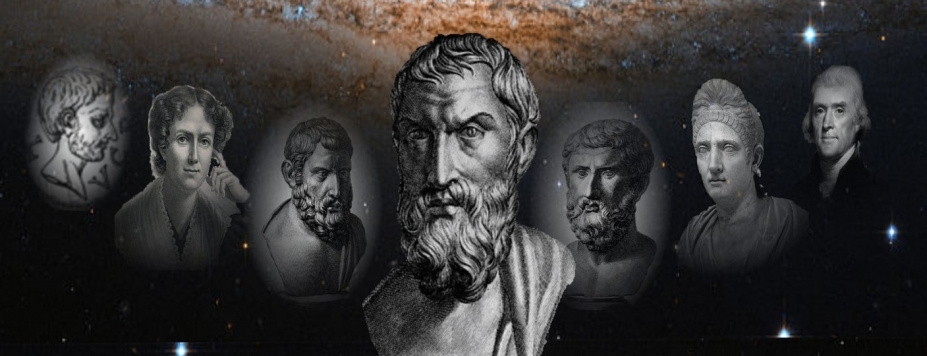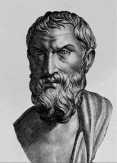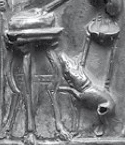The following is the translation of Cyril Bailey, which can be viewed in the original with side-by-side Greek here.
The Letter to Pythocles
CLEON brought me a letter from you in which you continue to express a kindly feeling towards me, which is a just return for my interest in you, and you attempt with some success to recall the arguments which lead to 5 life of blessedness. You ask me to send you a brief argument about the phenomena of the sky in a short sketch, that you may easily recall it to mind. For you say that what I have written in my other works is hard to remember, even though, as you state, you constantly have them in your hands I was glad to receive your request and felt constrained to answer it by pleasant expectations for the future. Therefore, as I have finished all my other writings I now intend to accomplish your request, feeling that these arguments will be of value to many other persons as well, and especially to those who have but recently tasted the genuine inquiry into nature, and also to those who are involved too deeply in the business of some regular occupation. Therefore lay good hold on it, keep it in mind, and go through it all keenly, together with the rest which I sent in the small epitome to Herodotus.
First of all then we must not suppose that any other object is to be gained from the knowledge of the phenomena of the sky, whether they are dealt with in connection with other doctrines or independently, than peace of mind and a sure confidence, just as in all other branches of study. We must not try to force an impossible explanation, nor employ a method of inquiry like our reasoning either about the modes of life or with respect to the solution of other physical problems: witness such propositions as that ‘the universe consists of bodies and the intangible,’ or that ‘the elements are indivisible,’ and all such statements in circumstances where there is only one explanation which harmonizes with phenomena. For this is not so with the things above us: they admit of more than one cause of coming into being and more than one account of their nature which harmonizes with our sensations. For we must not conduct scientific investigation by means of empty assumptions and arbitrary principles, but follow the lead of phenomena: for our life has not now any place for irrational belief and groundless imaginings, but we must live free from trouble. Now all goes on without disturbance as far as regards each of those things which may be explained in several ways so as to harmonize with what we perceive, when one admits, as we are bound to do, probable theories about them. But when one accepts one theory and rejects another, which harmonizes as well with the phenomenon, it is obvious that he altogether leaves the path of scientific inquiry and has recourse to myth. Now we can obtain indications of what happens above from some of the phenomena on earth: for we can observe how they come to pass, though we cannot observe the phenomena in the sky: for they may be produced in several ways. Yet we must never desert the appearance of each of these phenomena, and further, as regards what is associated with it, must distinguish those things whose production in several ways is not contradicted by phenomena on earth.
A world is a circumscribed portion of sky, containing heavenly bodies and an earth and all the heavenly phenomena, whose dissolution will cause all within it to fall into confusion: it is a piece cut off from the infinite and ends in a boundary either rare or dense, either revolving or stationary: its outline may be spherical or three-cornered, or any kind of shape. For all such conditions are possible, seeing that no phenomenon is evidence against this in our world, in which it is not possible to perceive an ending. And that such worlds are infinite in number we can be sure, and also that such a world may come into being both inside another world and in an interworld, by which we mean a space between worlds; it will be in a place with much void, and not in a large empty space quite void, as some say: this occurs when seeds of the right kind have rushed in from a single world or interworld, or from several: little by little they make junctions and articulations, and cause changes of position to another place, as it may happen, and produce irrigations of the appropriate matter until the period of completion and stability, which lasts as long as the underlying foundations are capable of receiving additions. For it is not merely necessary for a gathering of atoms to take place, nor indeed for a whirl and nothing more to be set in motion, as is supposed, by necessity, in an empty space in which it is possible for a world to come into being, nor can the world go on increasing until it collides with another world, as one of the so-called physical philosophers says. For this is a contradiction of phenomena.
Sun and moon and the other stars were not created by themselves and subsequently taken in by the world, but were fashioned in it from the first and gradually grew in size by the aggregations and whirlings of bodies of minute parts, either windy or fiery or both, for this is what our sensation suggests. The size of sun (and moon) and the other stars is for us what it appears to be; and in reality it is either (slightly) greater than what we see or slightly less or the same size: for so too fires on earth when looked at from a distance seem to the senses. And every objection at this point will easily be dissipated, if we pay attention to the clear vision, as I show in my books about nature. The risings and settings of the sun, moon, and other heavenly bodies may be due to kindling and extinction, the composition of the surrounding matter at the places of rising and setting being such as to lead to these results: for nothing in phenomena is against it. Or again, the effect in question might be produced by their appearance over the top of the earth, and again the interposition of the earth in front of them: for once more nothing in phenomena is against it. Their motions may not impossibly be due to the revolution of the whole heaven, or else it may remain stationary, and they may revolve owing to the natural impulse towards the east, which was produced at the beginning of the world . . . . . by an excessive heat owing to a spreading of the fire which is always moving on to the regions nearest in succession. The tropics of sun and moon may be caused owing to an obliquity of the whole heaven, which is constrained into this position in the successive seasons; or equally well by an outward impulsion of a current of air, or because the appropriate material successively catches fire, as the former fails; or again, from the beginning this particular form of revolution may have been assigned to these stars, so that they move in a kind of spiral. For all these and kindred explanations are not at variance with any clear-seen facts, if one always clings in such departments of inquiry to the possible and can refer each point to what is in agreement with phenomena without fearing the slavish artifices of the astronomers.
The wanings of the moon and its subsequent waxings might be due to the revolution of its own body, or equally well to successive conformations of the atmosphere, or again to the interposition of other bodies; they may be accounted for in all the ways in which phenomena on earth invite us to such explanations of these phases; provided only one does not become enamoured of the method of the single cause and groundlessly put the others out of court, without having considered what it is possible for a man to observe and what is not, and desiring therefore to observe what is impossible. Next the moon may have her light from herself or from the sun. For on earth too we see many things shining with their own, and many with reflected light. Nor is any celestial phenomenon against these explanations, if one always remembers the method of manifold causes and investigates hypotheses and explanations consistent with them, and does not look to inconsistent notions and emphasize them without cause and so fall back in different ways on different occasions on the method of the single cause. The impression of a face in the moon may be due to the variation of its parts or to interposition or to any one of many causes which might be observed, all in harmony with phenomena. For in the case of all celestial phenomena this process of investigation must never be abandoned – for if one is in opposition to clear-seen facts, he can never have his part in true peace of mind.
The eclipse of sun and moon may take place both owing to their extinction, as we see this effect is produced on earth, or again by the interposition of some other bodies, either the earth or some unseen body or something else of this sort. And in this way we must consider together the causes that suit with one another and realize that it is not impossible that some should coincide at the same time. Next the regularity of the periods of the heavenly bodies must be understood in the same way as such regularity is seen in some of the events that happen on earth. And do not let the divine nature be introduced at any point into these considerations, but let it be preserved free from burdensome duties and in entire blessedness. For if this principle is not observed, the whole discussion of causes in celestial phenomena is in vain, as it has already been for certain persons who have not clung to the method of possible explanations, but have fallen back on the useless course of thinking that things could only happen in one way, and of rejecting all other ways in harmony with what is possible, being driven thus to what is inconceivable and being unable to compare earthly phenomena, which we must accept as indications.
The successive changes in the length of nights and days may be due to the fact that the sun’s movements above the earth become fast and then slow again because he passes across regions of unequal length or because he traverses some regions more quickly or more slowly, (or again to the quicker or slower gathering of the fires that make the sun), as we observe occurs with some things on earth, with which we must be in harmony in speaking of celestial phenomena. But those who assume one cause fight against the evidence of phenomena and fail to ask whether it is possible for men to make such observations.
Signs of the weather may occur owing to the coincidence of occasions, as happens with animals we can all see on earth, and also through alterations and changes in the atmosphere. For both these are in accordance with phenomena. But under what circumstances the cause is produced by this or that, we cannot perceive.
Clouds may be produced and formed both by the condensation of the atmosphere owing to compression by winds and by the interlacing of atoms clinging to one another and suitable for producing this result, and again by the gathering of streams from earth and the waters: and there are several other ways in which the formation of such things may not impossibly be brought about. And from them again rain may be produced if they are squeezed in one part or changed in another, or again by a downward current of wind moving through the atmosphere from appropriate places, a more violent shower being produced from certain conglomerations of atoms suited to create such downfalls.
Thunder may be produced by the rushing about of wind in the hollows of the clouds, as happens in vessels on earth, or by the reverberation of fire filled with wind inside them, or by the rending and tearing of clouds, or by the friction and bursting of clouds when they have been congealed into a form like ice: phenomena demand that we should say that this department of celestial events, just like them all, may be caused in several ways.
And lightnings too are produced in several ways: for both owing to the friction and collision of clouds a conformation of atoms which produces fire slips out and gives birth to the lightning, and owing to wind bodies which give rise to this flash are dashed from the clouds: or compression may be the cause, when clouds are squeezed either by one another or by the wind. Or again it may be that the light scattered abroad from the heavenly bodies is taken in by the clouds, and then is driven together by the movement of the clouds and wind, and falls out through the clouds; or else light composed of most subtle particles may filter through the clouds, whereby the clouds may be set on fire by the flame and thunder produced by the movement of the fire.
Or the wind may be fired owing to the strain of motion and its violent rotation, or clouds may be rent by wind and atoms fall out which produce fire and cause the appearance of lightning. And several other methods may easily be observed, if one clings always to phenomena and can compare what is akin to these things. Lightning precedes thunder in such a conformation of the clouds, either because at the moment when the wind dashes in, the formation of atoms which gives rise to lightning is driven out, but afterwards the wind whirls about and produces the reverberation; or because they both dash out at the same moment, but lightning moves at a higher speed towards us, and thunder comes after, as in the case of some things seen at a distance and producing blows.
Thunderbolts may occur because there are frequent gatherings of wind, which whirls about and is fanned into a fierce flame, and then a portion of it breaks off and rushes violently on the places beneath, the breaking taking place because the regions approached are successively denser owing to the condensation of clouds, or as the result of the actual outburst of the whirling fire, in the same way that thunder may be produced, when the fire becomes too great and is too violently fanned by wind and so breaks through the cloud, because it cannot retreat to the next regions owing to the constant condensation of clouds one on the other. And thunderbolts may be produced in other ways too. Only superstition must be excluded, as it will, if one successfully follows the lead of seen phenomena to gain indications about the invisible.
Cyclones may be produced either by the driving down of a cloud into the regions below in the form of a pillar, because it is pushed by the wind gathered inside it and is driven on by the violence of the wind, while at the same time the wind outside impels it sideways; or by wind forming into circular motion, while mist is simultaneously thrust down from above; or when a great rush of wind takes place and cannot pass through sideways owing to the surrounding condensation of the atmosphere. And when the spout is let down on to the land, whirlwinds are produced in all the various ways in which their creation may occur owing to the movement of the wind, but if it reaches the sea it produces waterspouts.
Earthquakes may be brought about both because wind is caught up in the earth, so that the earth is dislocated in small masses and is continually shaken, and that causes it to sway. This wind it either takes into itself from outside, or else because masses of ground fall in into cavernous places in the earth and fan into wind the air that is imprisoned in them. And again, earthquakes may be brought about by the actual spreading of the movement which results from the fall of many such masses of ground and the return shock, when the first motion comes into collision with more densely packed bodies of earth. There are also many other ways in which these motions of the earth may be caused.
….
The winds may be produced when from time to time some alien matter is continually and gradually forcing its way in, or owing to the gathering of a vast quantity of water. The other winds arise when a few (currents of air) fall into many hollow spaces, and cause a spreading of wind.
Hail is produced both by a powerful congelation, when certain windy bodies form together from all sides and split up: also by a more moderate congelation of watery bodies and their simultaneous division, which causes at one and the same time their coagulation and separation, so that they cling together as they freeze in their separate parts as well as in their whole masses. Their circular shape may possibly arise because the comers melt off all round or because at their conformation bodies, whether watery or windy, come together evenly from all directions part by part, as is alleged.
Snow may be produced when fine particles of rain are poured out of the clouds owing to the existence of pores of suitable shape and the strong and constant compression by winds of clouds of the right kind; and then the water is congealed in its descent owing to some conformation of excessive coldness in the clouds in the lower regions. Or else owing to congelation in clouds of uniform thinness an exudation of this kind might arise from watery clouds lying side by side and rubbing against one another: for they produce hail by causing coagulation, a process most frequent in the atmosphere. Or else, owing to the friction of congealed clouds, these nuclei of snow may find occasion to break off. And there are many other ways in which snow may be produced.
Dew may be produced both when such particles as are productive of this kind of moisture issue from the atmosphere and meet one another, and also when particles rise from moist regions or regions containing water, in which dew is most naturally produced, and then meet together and cause moisture to be produced, and afterwards fall back on the ground below, as (is) frequently (seen) to be the case in phenomena on earth as well. (And frost is produced by a change) in the dew-particles, when such particles as we have described undergo a definite kind of congelation owing to the neighborhood of a cold atmosphere.
Ice is caused both by the squeezing out from the water of particles of round formation and the driving together of the triangular and acute-angled particles which exist already in the water, and again by the addition from without of particles of this kind, which when driven together produce a congelation in the water, by squeezing out a certain number of the round particles.
The rainbow is caused by light shining from the sun on to watery atmosphere: or else by a peculiar union of light and air, which can produce the special qualities of these colours whether all together or separately; from it as it reflects back again the neighboring regions of the air can take the tint which we see, by means of the shining of the light on to its various parts. The appearance of its round shape is caused because it is perceived by our sight at equal distance from all its points, or else because the atoms in the air or those in the clouds which are derived from the same air, are pressed together in this manner, and so the combination spreads out in a round shape.
A halo round the moon is caused either when air is carried towards the moon from all sides, or when the air checks the effluences carried from the moon so equably that it forms them into this cloudy ring all round without any gaps or differences, or else when it checks the air round the moon uniformly on all sides so as to make that which encircles it round and thick in texture. This comes to pass in different parts either because some current outside forces the air or because heat blocks the passages in such a way as to produce this effect.
Comets occur either when fire is collected together in certain regions at certain intervals of time in the upper air because some gathering of matter takes place, or when at certain intervals the heaven above us has some peculiar movement, so that stars of this nature are revealed, or when they themselves at certain seasons start to move on account of some gathering of matter and come into the regions within our ken and appear visible. And their disappearance occurs owing to the opposite causes to these.
Some stars ‘revolve in their place’(as Homer says), which comes to pass not only because this part of the world is stationary and round it the rest revolves, as some say, but also because a whirl of air is formed in a ring round it, which prevents their moving about as do the other stars: or else it is because there is not a succession of appropriate fuel for them, but only in this place in which they are seen fixed. And there are many other ways in which this may be brought about, if one is able to infer what is in agreement with phenomena.
That some of the stars should wander in their course, if indeed it is the case that their movements are such, while others do not move in this manner, may be due to the reason that from the first as they moved in their circles they were so constrained by necessity that some of them move along the same regular orbit, and others along one which is associated with certain irregularities: or it may be that among the regions to which they are carried in some places there are regular tracts of air which urge them on successively in the same direction and provide flame for them regularly, while in other places the tracts are irregular, so that the aberrations which we observe result.
But to assign a single cause for these occurrences, when phenomena demand several explanations, is madness, and is quite wrongly practiced by persons who are partisans of the foolish notions of astrology, by which they give futile explanations of the causes of certain occurrences, and all the time do not by any means free the divine nature from the burden of responsibilities.
That some stars should be seen to be left behind by others is caused because though they move round in the same orbit they are carried along more slowly, and also because they really move in the opposite direction though they are dragged back by the same revolution: also because some are carried round through a greater space and some through a lesser, though all perform the same revolution. But to give a single explanation of these occurrences is only suitable to those who wish to make a show to the many.
What are called falling stars may be produced in part by the rubbing of star against star, and by the falling out of the fragments wherever an outburst of wind occurs, as we explained in the case of lightning-flashes: or else by the meeting of atoms productive of fire, when a gathering of kindred material occurs to cause this, and a movement in the direction of the impulse which results from the original meeting; or else by a gathering of wind in certain dense and misty formations, and its ignition as it whirls round, and then its bursting out of what encloses it and its rush towards the spot to which the impulse of its flight tends. And there are other ways in which this result may be brought about, quite free from superstition.
The signs of the weather which are given by certain animals result from mere coincidence of occasion. For the animals do not exert any compulsion for winter to come to an end, nor is there some divine nature which sits and watches the outgoings of these animals and then fulfills the signs they give. For not even the lowest animal, although ‘a small thing gives the greater pleasure,’ would be seized by such foolishness, much less one who was possessed of perfect happiness.
All these things, Pythocles, you must bear in mind; for thus you will escape in most things from superstition and will be enabled to understand what is akin to them. And most of all give yourself up to the study of the beginnings and of infinity and of the things akin to them, and also of the criteria of truth and of the feelings, and of the purpose for which we reason out these things. For these points when they are thoroughly studied will most easily enable you to understand the causes of the details. But those who have not thoroughly taken these things to heart could not rightly study them in themselves, nor have they made their own the reason for observing them.












